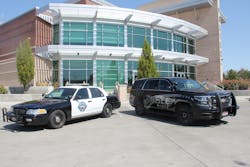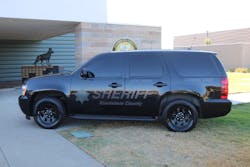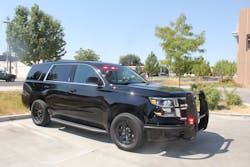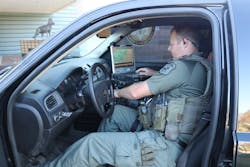The History & Evolution Of Patrol Vehicles...What’s Next?
There was a time when mechanics and outward design were the largest year-to-year changes in any automobile, much less the law enforcement patrol vehicle (LEPV). During the years prior to 1980, LEPVs were largely whatever the head of the given agency selected and they were suited to the intended purpose. Sedans were most often selected for urban use while you might be more inclined to see a pick-up truck or motorcycle in the rural areas.
The focus on design in the purchase selection was more about intended use and function than on appearance and uniformity. In fact, there was a time where a great many LEPVs were whatever the officer himself provided and equipped.
In today’s high-tech world, the idea of an officer providing his own LEPV, fully equipping it, marking it and using it day-to-day is not only unheard of, it’s ludicrous and cost prohibitive. But today’s high-tech world is very different from the days before portable two-way radios, cellphones, mobile data terminals, etc. The world back then, especially for law enforcement, was radically different. It was simpler and more straightforward.
Back then, a vehicle might have one simple marking on it: POLICE or SHERIFF. It was probably painted on because there were no stick-on vinyl decals. Nothing was reflective. There were no full vehicle length stripes. There were no two-way radios in the cars in a lot of places and if the officer was carrying a shotgun it was either just put in the trunk (bag or case optional) or it was muzzle-down in between the middle hump and the passenger’s seat.
“Emergency lights and siren” were a single rotating beacon (if anything at all) and a single-sound siren speaker for a long time. The necessity of emergency notification equipment like lights and sirens weren’t originally considered mandatory. After all, everyone had the responsibility to look for, see, and get out of the way of an LEPV responding to a call for service or emergency situation. Then, in the 1960s, 1970s and 1980s, things began to really change.
From 1960 to 1990
Between 1960 and 1990, LEPVs evolved a great deal. They evolved from the barely marked with essentially no emergency equipment sedan into the basic foundation of what we know as a LEPV today—a portable, fully functional office that is constantly data connected and highly visible thanks to all the lights and audio emergency notification equipment. When you think about it, most LEPVs today also double as basic corrections holding facilities as well.
In the early and mid-1980s, the Dodge Diplomat was a common LEPV. As were the Chevrolet Malibu, Chevrolet Caprice and the Ford Crown Victoria. The Dodge Coronet also made appearances for several years, predominantly without any markings. You saw pickup trucks only in the more rural areas. In the urban areas you might have had the rare evidence collection dedicated vehicle and that was a full size van.
In the late 1980s a few police departments toyed with the idea of smaller and less powerful vehicles, focusing on fuel efficiency and the attached cost. When the Plymouth K-car was first used, many folks who scoffed at the idea. It certainly had its place for urban patrol where risk of a vehicle chase was limited. After all, even a Chevy Chevette would outrun it. The agencies learned their lesson and the more fuel efficient vehicles with their four-cylinder engines were relegated to parking and code enforcement (in most places).
Then the automotive industry went through some major changes in the late 1980s and early 1990s and the resulting changes to vehicles greatly impacted LEPVs. Gone were the “full size” sedans like the Chevrolet Caprice and Malibu. The Diplomat and Coronet disappeared. Ford’s Crown Victoria stuck around but was gradually adjusted down in overall size and weight. The mid-size sedan was born and many agencies adopted the slightly smaller vehicles. Do you remember in 1987 when the movie “Robocop” showing all of the LEPVs as a Ford Taurus? Do you remember everyone scoffing at the idea that a vehicle that size, or one with front wheel drive, would be a proper LEPV? Think about what those folks are saying now.
The Chevrolet Impala and Malibu finally made a return to production but both were now mid-size sedans. The Ford Crown Victoria steadily adjusted exterior appearance, frame material, etc. but maintained that “full size” interior feel. More and more, as mid-size sedans became accepted, the price points started to get closer to those of SUVs. As a result, and given that law enforcement officers have to patrol year-round, more agencies started buying SUVs as their “standard” LEPV.
By the early 1990s, the Commission on Accreditation for Law Enforcement (CALEA) had released standards that required certain markings and lighting for emergency vehicles if the agency wanted to achieve CALEA certification. Among those requirements was front-to-rear (full length) reflective marking as well as 360-degree emergency lighting. As a result, the standard door seal POLICE/SHERIFF markings gave way to elaborate marking graphics that incorporated the necessary wording along with the jurisdiction seal and that full length reflective marking required. For unmarked emergency vehicles, the 360-degree lighting was still required.
Add-on equipment expands
The lighting for LEPVs certainly evolved from the late 1970s to the mid-1990s and hasn’t slowed down much. Emergency sound and light systems grew. They went from the single or double slowly rotating incandescent light under a colored dome to light bars that had four to eight rotating lights and reflectors between them with a siren in the middle. One of the biggest challenges of the early lighting systems was the fragility of the lights themselves. Breaking a bulb was easy and let’s be honest—LEPVs saw a lot of abuse. From ramming bad guys’ cars to going over bumps and down dirt roads, the lights got shaken up and jarred quite a bit. We needed a more robust and rugged system.
While Light Emitting Diode (LED) bulbs had been around since 1962, they had never generated enough light from a small enough power source to be of use in flashlights or on emergency vehicles. That changed in the 1990s as scientific advancement of the lights allowed them to be brighter (i.e generate more light) and be driven by smaller power sources. It took a while for the law enforcement industry to adopt the idea of putting LEDs into light bars because, quite frankly, we were stuck on rotating lights for the flashing effect and 360-degree visibility.
Strobe lights had been in use for quite some time in the 1990s but the power supplies were a pain to wire in and the systems required separate control boxes or switches.
Also in the early 1990s, we began to see Mobile Data Terminals (MDTs) going into LEPVs. In the beginning, we saw multiple builds and formations of the assorted equipment that was connected to the MDT. Everything from ruggedized tablets with radios in the trunk to laptops and cellular connections were used. From one jurisdiction to the next you could see a wide variety of MDT components and connectivity solutions. At the same time, just two counties over you might find agencies still trying to integrate mobile two-way radios into all of their LEPVs. The difference was budget allotment and the executive running the agency. MDTs evolved along with everything else that goes into or onto LEPVs. In today’s world, we can see ruggedized laptops in many vehicles but we also see handheld units in motorcycle saddlebags or mounted onto ATV handlebars/equipment racks.
What’s next?
Nearing the end of the second decade of the 21st century, we’ve seen a lot of change in our vehicles—which also now include “smart” and electric models—as well as improvements in the emergency lighting, sound systems, markings and MDTs. Technology in general is changing at a seemingly increasing rate. That will doubtlessly impact the LEPVs of the future.
Given the last ten years as an indicator, we can expect to see the mid-size SUV used more frequently in rural areas and ever smaller/more fuel efficient vehicles used in cities. Markings, while still reflective, are often subdued or “stealth”—we may see more of that.
Interestingly, the black-and-white classic law enforcement markings made famous by the Los Angeles Police Department are being incorporated more and more nationwide. As agencies seek ways to keep overall cost down, compromises are made and that often drives the trends of markings as well as equipment.
One thing we can all count on is that fuel cost will never go away. While fuel efficiency slowly increases, the efficiency and power of electric cars are growing at an accelerated rate. Unfortunately, the cost attached isn’t affordable for public agencies yet, although that may come in the next 10 to 20 years.
The basic purposes of the LEPV will never change though. It provides a safe and convenient means of getting officers to the scenes of emergencies in a timely fashion as well as providing a constant crime deterrent through visibility and presence in the community.

Lt. Frank Borelli (ret), Editorial Director | Editorial Director
Lt. Frank Borelli is the Editorial Director for the Officer Media Group. Frank brings 20+ years of writing and editing experience in addition to 40 years of law enforcement operations, administration and training experience to the team.
Frank has had numerous books published which are available on Amazon.com, BarnesAndNoble.com, and other major retail outlets.
If you have any comments or questions, you can contact him via email at [email protected].






